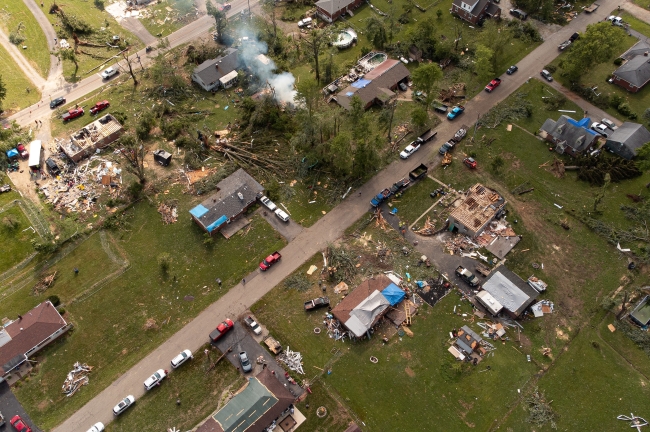The 2022 hurricane season could bring a high number of storms and significant damage. While property owners are making sure they have their supplies and emergency plans in order, insurers need to prepare for spike in claims that hurricanes can bring. Artificial intelligence is proving to be a valuable tool in the management of hurricane claims.
The 2022 Atlantic Hurricane Season Forecast
Recent hurricane seasons have seen higher than normal activity. If you’re hoping for a break in 2022, you may be disappointed.
According to the National Oceanic and Atmospheric Administration, 2021 was the sixth consecutive above-normal Atlantic hurricane season. This may be due to a warm phase of the Atlantic Multidecadal Oscillation pattern. At the same time, climate change is expected to result in more intense storms, with a higher proportion of tropical cyclones reaching Category 4 to 5 levels.
AccuWeather’s 2022 Atlantic hurricane season forecast says that we should expect the trend of above-normal hurricane activity to continue. The forecast predicts the following:
- 16 to 20 named storms
- Six to eight hurricanes
- Three to five major hurricanes
- Four to six storms with direct U.S. impact
The Start of the Hurricane Season
The Atlantic hurricane season officially runs from June 1 to November 30. However, this does not mean that storms won’t form before June.
Hurricanes are not unheard of as early as May and as late as December, and occasionally, they may form even earlier or later. According to Weather Underground, in 2017, Tropical Storm Arlene formed in April. This was the third time on record that an Atlantic tropical storm formed in April.
AccuWeather warns that a preseason storm is likely this year. There has also been discussion about whether the official state date of June 1 should be modified. Ken Graham, the National Hurricane Center Director, says that early-season tropical activity has occurred seven years in a row in what appears to be a trend.
Developing More Accurate Risk Models
Artificial intelligence and machine learning are useful in risk modeling, and improvements in these areas are leading to better, more accurate models.
According to the Pacific Northwest National Laboratory, machine learning has improved the predictive power of hurricane models to help us better understand rapid intensification. This is important because many hurricane forecasts have sometimes failed, for example, by telling people to expect a Category 2 storm that actually ends up being a Category 4. Algorithms that utilize machine learning can form more accurate predictions about storm intensification.
Insurers can leverage better risk models to improve underwriting processes. This is important because hurricanes are some of the costliest disasters. According to the Insurance Information Institute, eight of the 10 costliest natural catastrophes and all of the top seven costliest natural catastrophes in the U.S. have been hurricanes.
Using Artificial Intelligence to Take Control of Claims
Better risk models can also help insurers prepare for surges in claims, manage claims and allocate resources accordingly.
When a widespread natural disaster like a hurricane strikes, insurers can be inundated with claims. According to the Louisiana Department of Insurance, policyholders in Louisiana filed 323,727 claims related to three hurricanes and tropical storms in 2020. As of September 30, 2021, only 68% of the claims were closed with payment. These numbers do not include claims or payments that are part of the National Flood Insurance Program.
For affected policyholders, each of these claims is urgent. However, for the insurers, managing the high volume of claims in a timely manner can be challenging. Losses may also be difficult to assess if the area is hard to access due to the natural disaster. At the same time, insurers need to ensure that claims are settled accurately, and they must be on the lookout for the fraudulent claims that can occur as some dishonest individuals take advantage of natural disasters to fake or pad their insurance claims.
Artificial intelligence and automation can help. In recent years, more insurers and policyholders have embraced AI-powered claims processes for auto claims, but the potential extends far beyond auto claims. By leveraging artificial intelligence and automation, claims handlers can automate routine tasks to boost efficiency, cut costs and decrease claims cycle length.
Automation can also improve communication with claimants. A busy claims professional might fall behind on updates to claimants, but this can result in policyholders feeling confused and uncertain about the process, resulting in lower satisfaction levels. By automating communication, claims professionals can keep claimants in the loop without becoming overburdened.
Know You’re Ready
With VCA Software’s claims management platform, you can triage and distribute a massive number of claims in minutes. Best of all, there’s still time to get you onboarded before storm season, with the following capabilities:
- Visual File Handler Assignment (tracks skills, geography and licenses)
- Auto Assign
- Auto Acknowledge
- File Handler Payout Reporting
- So Much More!
Don’t wait another day to request a demo.





